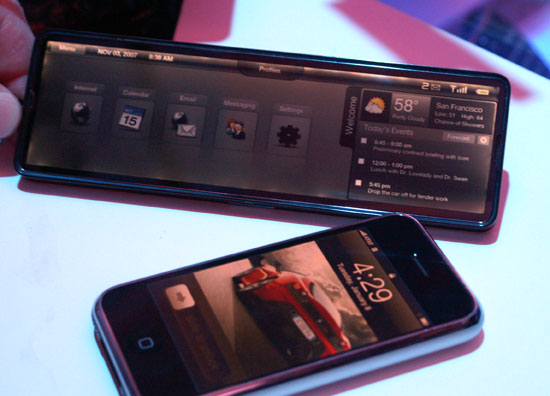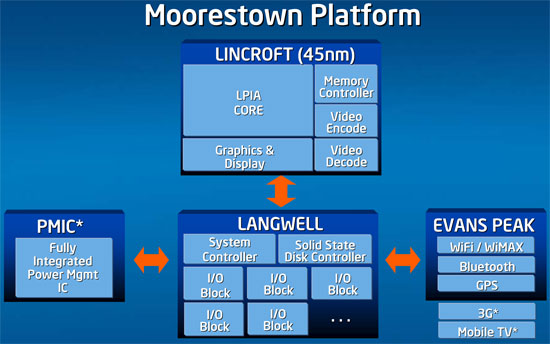Intel's Atom Architecture: The Journey Begins
by Anand Lal Shimpi on April 2, 2008 12:05 AM EST- Posted in
- CPUs
Final Words
Over the next six months we will begin seeing the first devices based on Intel's Atom processor. For 2008, Intel expects to see Atom used primarily in 5" form factor MIDs (Mobile Internet Devices). I've played with prototypes of these Atom based MIDs and honestly, they are not any more impressive than the UMPCs that preceded them. The interfaces are sluggish, the devices are still too bulky and I'm not completely convinced that they're worth the added hassle of carrying one around with me all day.
Intel seems to think that Atom based portable GPS devices will be some of the more interesting devices out this year, and while I see some potential there I'm just not that excited.
It's a shame because I am quite excited about the Atom processor, or its future to be more specific. I'm honestly fed up with poor performance in just about every consumer electronics device that I live with - I want the sort of responsiveness that I get with my desktop or notebook, but I want that in my cable box, in my TVs, mobile phones, Blu-ray players, toasters, etc...
The first iteration of Atom simply won't deliver on enough fronts to make the sort of revolutionary changes I want. It lacks the level of integration necessary for truly portable devices and where I really want to see it isn't in bulky MIDs and UMPCs, but rather in things like the iPhone.

The iPhone (bottom) and a mockup of what the Atom could be in within 3 years (top)
I don't have high expectations for Atom today, while it will surely enable even more EeePC-like devices it's the processor's future that I'm most interested in - and Intel is too. You can find Intel silicon in the majority of desktop and notebook PCs shipped, but if Intel were able to make Atom a success you would find Intel in much, much more. TVs, phones, set top boxes, MIDs, all of these would be running x86 and potentially Intel processors. We always wondered what Intel would do to its spare fab capacity if it integrated a north bridge/memory controller onto its CPUs, with Atom we now have that answer.
The beauty of Atom being successful in these markets is that it doesn't just benefit Intel but AMD and the markets as a whole. Intel will be in for a fight once it begins competing with ARM based processors for space in the CE market, which should promote competition. In those areas where Intel does manage to bring x86 where it hasn't been before, those will quickly become areas where AMD can offer an Atom alternative. Remember that AMD built much of its CPU business on offering a more cost effective x86 alternative to Intel; there's no reason to believe that the same trend won't continue should Atom become successful in the CE industry.
Competition is a very good thing and it's rare that Intel plays the underdog in an industry, but with Atom it most definitely is. The road ahead will be a long one for Intel and its new baby, but the future does look very bright:

What made Atom possible is also what will make it better over time. Moore's law should mean some very interesting things are in store for the processor. The Moorestown update will bring about a more integrated solution, finally enabling Atom to find its way into larger smart phones.

Moorestown will bring an integrated memory controller to Atom among other things...
Take things one step further with an eventual 32nm shrink of Moorestown in the 2011/2012 timeframe and I think we may just be able to have x86 everywhere at the start of the next decade.










46 Comments
View All Comments
FlakeCannon - Wednesday, April 2, 2008 - link
This was an absolutely fantastic article as far as I'm concerned. One of the best I've read from AnandTech. I'm truly impressed with the amount of effort and dedication that the engineers at Intel put into the Atom. Thought the consumer may not see its importance today the Atom will continue to develop one throughout the next 2 years and show why this is such a huge step in the right direction. I really think that this article outlines very well the architecture involved and where it intends to lead Intel and others in the future.I'm always impressed to see Intel take architecture that was revolutionary in its time 15 years ago in the Pentium and Pentium Pro and resurrect it in modern day fashion with help of the Dothan Pentium M architecture and even things borrowed from the miserable Netburst technology that 15 years later I believe will once again create a product revolutionary in nature. I was never able to appreciate it in the days of the Pentium but certainly can now.
This is one product I think is deserving of being excited about.
fitten - Wednesday, April 2, 2008 - link
What does an on-die memory controller have to do with ILP?Anand Lal Shimpi - Wednesday, April 2, 2008 - link
Woops, I've clarified the statement :)Take care,
Anand
erwos - Wednesday, April 2, 2008 - link
I was thinking that this would be a fantastic platform for making a small, silent HTPC box for doing streaming media, but the lack of 1080p output kills that to a large extent. I know it's not a big priority for the first revision given the UMPC targeting, but I hope the "Atom 2" does try to squeeze that feature in.FITCamaro - Wednesday, April 2, 2008 - link
It could always be paired with a different, more capable graphics core.ltcommanderdata - Wednesday, April 2, 2008 - link
It;d be very interesting to see how the 1.86GHz Silverthorne stacks up against a 1.8GHz P4 Northwood, a 1.86GHz Dothan, a 1.8GHz Conroe-L based Celeron, and a 1.8GHz Athlon 64.I wonder if Apple is going to refresh AppleTV with Silverthorne since it seems ideal with replace the current 1GHz ULV Dothan in there.
yyrkoon - Wednesday, April 2, 2008 - link
Well at least Intel did not name their Atom CPUs the 'Atom Z80' . . . heh.Anyways, this is good for our future, as the mITX, and pITX 'systems' now days are still kind of large-ish, and cost quite a bit of money for what they are. Though, I think that putting a web browser on just any old appliance in the house would be way overkill, and possibly a very serious mistake. A TV with a web browser ? An Oven ? Please . . . this is why we have PCs, and micro mobile devices.
Recently a friend and myself have been working on an embedded project, and I can see the potential here, but a 'problem' does exist. Some of the things you would want to do with such a processor . . . well lets just say there still would not be enough processing power. That being said, I do not see why these could not help make a TVs/HD-DVD player menu operate faster.
pugster - Thursday, April 3, 2008 - link
It certainly sounds nice, but the atom processor cost alot because some of the higher end models cost more than $100 each. I find it surprising that their Polosbo chipset is manufactured at 130mm. It probably came from one of their foundries that was due to upgrade to 32mm sometime next year anyways. They could've earily manufactured at 65mm.Somehow I don't see their product as mature and maybe the next gen product they would have a cpu and the north/south bridge in the same die.
lopri - Wednesday, April 2, 2008 - link
I honestly don't get the excitement. Should I? I mean, I wouldn't feel comfortable with one gigantic company controlling every single electronics in our life. If Intel opens up the X86 and everyone can compete on even end, then maybe. Since that won't happen, the future looks scary enough.clnee55 - Wednesday, April 2, 2008 - link
NO, how can you get excitement. I am already bored with your conspiracy theory. Let's talk about tecnical issue here.